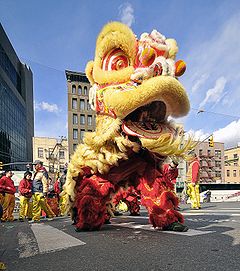Traditional Chinese dance
Lion dance (traditional Chinese: 舞獅; simplified Chinese: 舞狮; pinyin: wǔshī) is a form of traditional dance in Chinese culture and other Asian countries in which performers mimic a lion's movements in a lion costume to bring good luck and fortune. The lion dance is usually performed during the Chinese New Year and other traditional, cultural and religious festivals. It may also be performed at important occasions such as business opening events, special celebrations or wedding ceremonies, or may be used to honour special guests by the Chinese communities.
The Chinese lion dance is normally operated by two dancers, one of whom manipulates the head while the other manipulates the tail of the lion. It is distinguishable from the dragon dance which is performed by many people who hold the long sinuous body of the dragon on poles. The fundamental movements of the Lion dance can be found in Chinese martial arts[citation needed], and it is commonly performed to a vigorous drumbeat with gongs and cymbals.
There are two main forms of the Lion dance, the Northern Lion and the Southern Lion. Both forms are commonly found around the world especially in Southeast Asia, the Southern Lion predominates as it was spread by the Chinese diaspora communities who are historically mostly of Southern Chinese origin. Versions of lion dance related to the Chinese lion are also found in Japan, South Korea, Taiwan and Vietnam. Besides the Chinese-based lion dance, other forms of lion dance also exist in India, Indonesia, and East Africa.
